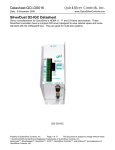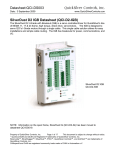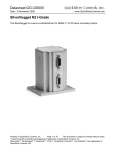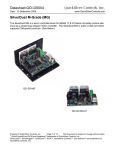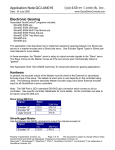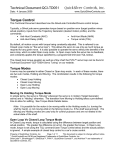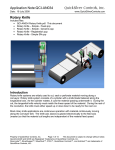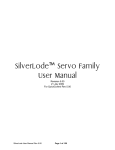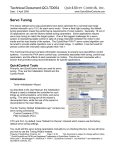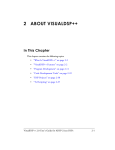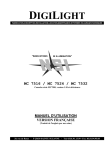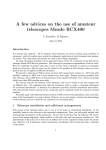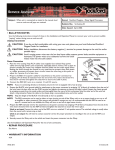Download Datasheet:QCI-DS018 QuickSilver Controls, Inc. SilverDust D2
Transcript
QuickSilver Controls, Inc. Datasheet:QCI-DS018 Date: 5 November 2008 www.QuickSilverControls.com SilverDust D2-IG8 Datasheet Servo controller/drivers for NEMA 11, 17 and 23 frame, high torque, direct drive servomotors. These SilverDust controllers share a compact DIN mount designed to save cabinet space. They are great for multi-axis systems. The Ethernet option adds easy networking capability. QCI-D2-IG8 8 isolated 24Volts I/O, 7 LVTTL I/O and CANopen®. QCI-D2-IG8-E IG8 plus Ethernet. QCI-D2-IG8 Property of QuickSilver Controls, Inc. Page 1 of 22 This document is subject to change without notice. QuickControl® and QCI® are Registered Trademarks of QuickSilver Controls, Inc. SilverLode™, SilverNugget™, SilverDust™, PVIA™, QuickSilver Controls™, and AntiHunt™ are trademarks of QuickSilver Controls, Inc.. QuickSilver Controls, Inc. Datasheet:QCI-DS018 System Overview Point-to-Point Moves • Relative or Absolute • Velocity or Time Based • S-Curve Advanced Motion Profile Moves • Profile Move Commands • Register Based o Position/Accel/Decel/Vel o Modify On-the-Fly Multi-Axis Linear Interpolation • XYZ Coords Contained in Text File • CANopen® used for local bus • 1000+ Points Stored In NV Memory Built-In Voltage Clamp • Regenerative Braking Resistor Input/Output • 8 5-24V Digital I/O o Bi-Directional o Isolated o Set While In Motion • 7 TTL Digital I/O o Use for QCI-BO-B52 24V I/O • 4 Analog Inputs (Joystick) • Analog Output Option • Programmable Limit Switch (PLS) • Secondary Encoder In • Encoder Out • SSI Encoder Option Program and Data Storage • 32K Non-Volatile Memory: • 2000-3000 Program Lines • User Data Examples o CAM Tables o Motion Profiles o Lookup Tables Electronic Slip Clutch/Brake • Variable Torque • Wind/Unwind Applications Anti-Hunt™ • Optionally use Open Loop While Holding • No Servo Dither While At Rest QuickSilver Controls, Inc. Page 2 of 22 Electronic Gearing/Camming • Follow Encoder (A/B Quadrature) or Step and Direction • Dynamic Gear Ratios o Integer Ratios 32767:1 to 1:32767 o Decimal Ratios to 7 Places • Electronic Cam o Import Tables From Text File o Over 2500 Points o Multiple Tables Communications • RS-485/RS-232 @ 230K Baud • ASCII,Binary,Modbus®,DMX512 • CANopen® • Ethernet (TCP/IP, Modbus TCP) • Host Control While Servo in Motion Programming Language • Easy, Menu Driven Interface • Command Parameter Prompts • No Syntax Errors • User Namable I/O and Registers Advance PVIA™ Servo Loop • 100:1 Inertial Mismatch • Direct Drive Oversized Inertial Loads o Flywheels/Belt Drives o Typically Without Gearheads • More Stable Than PID Digital 4 Quadrant Vector Drive • DSP Driven for Reduced Noise Multi-Task/Multi-Thread Compatible with QCI Motor/Encoders • NEMA 11 Frame o 4000 Counts/Rev Encoder o Up To 9 oz-in (continuous) • NEMA 17 Frame o 8000 Counts/Rev Encoder o Up To 43 oz-in (continuous) o IP50 or IP65 • NEMA 23 Frame o 8000 Counts/Rev Encoder o Up To 300 oz-in (continuous) o IP50 or IP65 UL, CUL, CE QuickSilver Controls, Inc. Datasheet:QCI-DS018 Electrical Specifications Input Power Voltage +12 VDC to +48 VDC, regulated. The controller must be initialized for the actual operating voltage using Initialization Wizard. Over-Voltage Protection Voltages exceeding +55 VDC will permanently damage the controller/driver electronics. All controllers include an onboard clamp circuit and braking resistor to dissipate excess current developed during re-generative braking (stopping). Reverse Polarity Protection Reverse polarity protection is provided. Note, however, if the power supply is not floating, connecting the V+ input to Ground will cause this potential to be present at the communications and I/O lines, which may damage these lines or that to which they are connected. Input Current 4 Amps maximum for any input voltage, +12 VDC to +48 VDC. Output Power Output/Driver Current Amps Per Phase: 3.5 Continuous/ 4.5 Peak with adequate heat dissipation (heat sink). Maximum Output Power 150 Watts continuous power with adequate heat dissipation. Encoder Interface From Motor Encoder: Quadrature (Differential) From External (Secondary) Encoder: Quadrature (Single or Differential), SSI This external encoder can be used for dual loop or electronic gearing applications. Note, CANopen® encoders may also be used through the CANopen communication bus. CANopen® and CiA® are registered community trade marks of CAN in Automation e.V. QuickSilver Controls, Inc. Page 3 of 22 QuickSilver Controls, Inc. Datasheet:QCI-DS018 Inputs & Outputs Standard I/O 7 I/O (1-7) Digital Inputs 0 to +3.3 VDC. LVTTL level compatible. Effective internal 200K ohm impedance to +3.3 V. Digital Output Voltage 0 / +3.3 VDC. Digital Output Current Sinking or Sourcing I/O 1, 4, 5, 7 outputs 4 mA MAX I/O 2 and 3 outputs 2 mA MAX I/O 6 outputs 8 mA MAX I/O Over-Voltage Protection An over-voltage limiter protects each standard I/O line up to 30 volts. Applying voltages greater than 30 volts will permanently damage the I/O. Analog Inputs 0 to +3.3 VDC input signal range. 10 bit ADC resolution (single). 11 bit ADC resolution (differential). Analog inputs 1 to 4 are mapped to share digital I/O lines 4 to 7. Each input has an effective internal 200K ohm impedance to +3.3 VDC. Analog signals are read every servo cycle (120 µsec.) and the converted analog data is processed through a 5 ms filter to reduce noise & transients. Analog Output Available on I/O 2, but requires Basic Breakout w/ Analog Output (QCI-BO-B1A). See technical document QCI-TD048. Driver Enable Inputs 10-48 Volts optically isolated differential inputs QuickSilver Controls, Inc. Page 4 of 22 QuickSilver Controls, Inc. Datasheet:QCI-DS018 Extended I/O 8 I/O (101-108) Input Power An internal isolated +5V power supply drives the I/O circuitry. The power supply is powered from the main power source through an isolated flyback converter. Input Isolated from processor / driver power. 0 to 5-36 VDC. 0-1V: Logic Low 2V-36V: Logic High Output Current Outputs are open drain and can sink up to 250mA per channel continuously. If the load draws more than the specified current, the I/O line will go into current/thermal limit mode causing the FET to turn off automatically. I/O Over-Voltage Protection Each I/O line will clamp at approximately 40-50 volts. Applying more than 40 volts may permanently damage the I/O lines. Internal I/O 201-203 I/O 201 through 203 are special purpose I/O and do not connect to external connectors User Status LED - I/O 201 I/O 201 provides access to a green user status LED, labeled as “201” located near the Processor Power switch. Configuring I/O 201 to a “1” or high state lights the LED while configuring it to a “0” or low state turns off the LED. Internal I/O 202 and 203 I/O 202 and I/O 203 provide access to the E-485 Bridge (bridge from Ethernet to RS-485) EIO2 and EIO3, respectively. These lines may be configured as input, high or low states. EIO2 and EIO3 are configurable via the Ethernet port, and may be used as either inputs or outputs. They may provide additional handshaking between the Ethernet applications and the local applications. For example, they may be used to trigger the E-485 Bridge to send an email message. Do not configure both the IO2 and EIO2 as outputs simultaneously; Do not configure both IO3 and EIO3 as outputs simultaneously. Communications Hardware Interfaces RS-232, RS-232 multi-drop, RS-485 multi-drop (software selectable) Ethernet (IG8-E and -ES options). This is a bridge from Ethernet to RS-485 (E-485 Bridge). The E-485 Bridge provides a bridge from Ethernet to the SilverDust RS-485 network. See Technical Document “QCI-TD056 E-485 Bridge-Ethernet”. QuickSilver Controls, Inc. Page 5 of 22 QuickSilver Controls, Inc. Datasheet:QCI-DS018 Protocols 8-bit ASCII, 9-bit binary, Modbus RTU, or Modbus® TCP. Hardware Configuration Settings Available Baud Rates: 2400, 4800, 9600, 19.2k, 28.8k, 57.6k, 115.2k or 230.4k Data Bits: 8 Stop Bits: 1.5 or 2 Parity Bit: None Controller Area Network (CAN) Software Required: Firmware Rev 29 (QuickControl Rev 4.5) See CANopen User Manual for hardware and software details. Note: By default, the rotary switches are used to configure Unit ID and CAN baud rate. The user may alternatively choose to configure the ID and CAN baud rate to fixed values and use these switches for other things in their application program. A red CAN ERR LED and a green CAN STATUS LED, located near the CAN BAUD switch, reflect the status of the CAN bus, as specified in the CANopen specifications. Both LED’s are off until after CAN is configured by setting CAN ID (CID). With CAN configured, the CAN ERROR LED (red) indicates the highest of the following errors: ON = BUS OFF – Not able to transmit data due to excess errors Double Flash = Heartbeat Error – Heartbeats being monitored have timed out Single Flash = Warning Limit Reached – Excessive CAN bus errors OFF = No error With the CAN configured, the CAN STATUS LED (Green) indicates the CAN NMT State: Off = CAN not initialized Blinking = Pre-Operational Single Flash = Stopped ON = Operational QuickSilver Controls, Inc. Page 6 of 22 QuickSilver Controls, Inc. Datasheet:QCI-DS018 Mechanical Specification QCI-D2-IG8 3.14 79.7 mm 1.90 48.2 mm 3.01 76.4 mm 1.45 36.8 mm 2.56 65.0 mm .56 14.2 mm .45 11.4 mm .19 4.7 mm 4.60 116.7 mm 4.60 116.7 mm 4.78 121.5 mm .08 2.0 mm TYP .125 3.2 mm .125 3.2 mm Note: See our website for 2D drawings and 3D models. Environmental Specifications Operational Temperature -10 C to +80 C Storage Temperature - 40 C to +85 C Humidity Continuous specification is 95% RH non-condensing. Shock Limitation is approximately 50g/11ms. IP Rating IP20 with cables attached. QuickSilver Controls, Inc. Page 7 of 22 .08 2.0 mm QuickSilver Controls, Inc. Datasheet:QCI-DS018 Connector Data Ethernet RJ45 (BP1) SSI Port (TP1) SSI / ENCODER BAUD ID Top Panel (TP) 1 Bottom Panel (BP) 2 ID Rotary Switch (TP2) 201 ENC CAN STATUS CAN ERR ON ETHERNET CAN CAN Daisy Chain RJ11 (BP2) PROC. OFF COMM www.QuickSilverControls.com Processor Switch (TP3) MOTOR/ENC 101 102 103 104 105 106 107 108 V+ L H VB/Tx A/Rx Gnd V+Pr V+ V- ISOLATED I/O GND I/O 101 I/O 102 I/O 103 I/O 104 I/O 105 I/O 106 I/O 107 I/O 108 CAN SHIELD CAN 12-24 VDC CAN L CAN H CAN 0 VDC RS232TX - RS485A RS232RX - RS485B Comm Ground V+ CLAMPED OUT DRIVER ENABLE + DRIVER ENABLE V+ Proccessor V+ V- or PGND QuickSilver Controls, Inc. COMM/IO SMI SMI Interface (BP3) Motor Interface (BP4) RS232-485 to Computer (TP4) IO GND CAN Input/Output (FP1) CAN Breakout (FP2) CAN TERM 485 TERM Ethernet B Ethernet A 485 TERM Config (FP3) Serial Comm (FP4) Power (FP5) Page 8 of 22 QuickSilver Controls, Inc. Datasheet:QCI-DS018 Front Panel (FP) (FP1) I/O Interface Breakout (FP2) CAN Interface Breakout (FP3) Ethernet Configuration/Termination Interface (FP4) Communication Interface Breakout (FP5) Power Interface Breakout Top Panel (TP) (TP1) RS-232-485 to Computer (TP2) Synchronous Serial Interface Port (SSI Port) – Optional (TP3) Rotary Switch (TP4) Processor Switch Bottom Panel (BP) (BP1) SMI Interface (BP2) Motor Interface (BP3) Ethernet Interface - Optional (BP4) CAN Daisy Chain Interface (FP1) I/O Interface Breakout Proximity Sensor Outputs Inputs Inputs ISO +24V SilverDust Internal Diagram 24V - 36V Supply + Load Load Load OPEN HIGH (1) I/O 103 Output Example Switch GND GND IO 101 IO 101 IO 102 IO 102 IO 103 IO 103 IO 104 IO 104 IO 105 IO 105 IO 106 IO 106 IO 107 IO 107 IO 108 IO 108 ISO GND Sinking Output configuration ON or LOW = closed circuit OFF or HIGH = open circuit Using the extended I/Os as an Input: All extended I/Os default to inputs. 2– 36 Volts = HIGH 0 to 1v LOW QuickSilver Controls, Inc. LED = OFF LED = ON QuickControl Display: Green QuickControl Display: RED Page 9 of 22 QuickSilver Controls, Inc. Datasheet:QCI-DS018 Each I/O is pulled up internally to a diode isolated +5 Volts, as well as to the associated LED through a resistor to the diode isolated +5v. An output driving one of these inputs requires a minimum of 4mA sinking current (LED + Pull-up resistor). Commands to Use the I/Os as an Output: Set Output Bit (SOB): Sets output HIGH (driver transistor is off) Clear Output Bit (COB): Sets output LOW (driver transistor is on) Configure I/O (CIO): Sets output HIGH/LOW/Tristate High and Tristate = OFF, Low=ON Configure I/O, Immediate Mode (CII): Same as CIO, but executable from host even while a program is running. See SilverLode Command Reference for more details on these commands. (FP2) CAN Interface Breakout V+ L H V- CAN SHIELD CAN 12-24 VDC CAN L CAN H CAN 0 VDC Controller Area Network (CAN) This high-speed up to 1-megabit/s bus allows for register and I/O sharing as well as interface to 3rd party CANopen devices (i.e. encoders, I/O modules,…). NOTE: CAN requires firmware rev 29 and QuickControl Rev 4.5. See SilverLode CANopen User Manual. Note: CAN V+ only connects to BP2 and is provided for external wiring convenience only. (FP3) Ethernet Configuration / Termination Interface CAN TERM 485 TERM Ethernet B Ethernet A 485 TERM • • • • CAN requires termination at both ends of the bus. Jumper “CAN Terminate” to terminate the bus. Jumper both “RS-485 Terminate” for RS-485 termination. This provides a biased termination for the bus. Jumper both “Ethernet Jumper” and both “RS-485 Terminate” for Ethernet. See Technical Document “QCI-TD056 E-485 Bridge-Ethernet”. (FP4) Communication Interface Breakout B/Tx A/Rx Gnd RS232TX - RS485A RS232RX - RS485B Comm Ground QuickSilver Controls, Inc. Standard RS-232/RS-485 connections broken out to terminals for easy wiring. Page 10 of 22 QuickSilver Controls, Inc. Datasheet:QCI-DS018 (FP5) Power Interface Breakout V+Pr V+ V- V+ CLAMPED OUT DRIVER ENABLE + DRIVER ENABLE V+ Proccessor V+ V- or PGND The two main items are V+ & V-, normally from the main power supply. V+Pr is a separate power input to keep the processor alive for certain applications. ENA+ and ENA- are inputs to an optically isolated drive enable. If Driver Enable is not needed, jumper ENA+ to CLMP and ENA- to V-. CLMP is a fused 500 mA output. CLMP = V+ minus 0.3V. (TP1) Serial Peripheral Interface / Synchronous Serial Interface Port (SPI/SSI Port) – Optional SPI 9 1 10 2 1 A_MOSI 2 A_MOSI + 3 B_SCLK 4 B_SCLK + 5 GND 6 +5v 7 Z_CS 8 Z_CS+ 9 MISO 10 MISO + SSI 1 NA 2 NA 3 SCLK + 4 SCLK 5 GND 6 +5v 7 NA 8 NA 9 Data 10 Data + SPI/SSI Port connects to third party devices that support SPI/SSI functions. Common uses for the SSI port are absolute encoders. This port may also be used to output internal single ended or differential quadrature encoder signals, as well as to input differential encoder signals (driving I/O 4,5,6) through software selection. See SSI, EMN and SEE commands. Note: SSI hardware uses the first clock pulse to sample and latch the position information, using the remaining clock pulses to transport data. 8 to 31 bits of information may be configured for the SSI port. QuickSilver Controls, Inc. Page 11 of 22 QuickSilver Controls, Inc. Datasheet:QCI-DS018 67 012 345 012 89A 7 6 B CD EF EF B CD 89A (TP2) Rotary Switch 345 Rotary switches are 4-bits each, 8-bits total. User can set Unid ID using the rotary switches. User also can select different program inside the servo by using the rotary switches. The default IG8 initialization program uses the right switch to set Unit ID (see IDT command), and the left switch to set CAN baud rate (See CBD command). However, either or both of these functions may be set conventionally, freeing these switches for user purposes. The data from these switches is available via CAN object 200A. (TP3) Processor Switch The Processor Switch turns on and off the power to the processor. The main power to the SilverDust should be OFF before connecting or disconnecting the system. The Processor Switch does NOT disconnect main power. It also does not turn off the power to the E-485 Bridge (bridge from Ethernet to RS-485) or to the 485-biased termination; this allows an E-485 Bridge to be shared with multiple 485 units. QuickSilver Controls, Inc. Page 12 of 22 QuickSilver Controls, Inc. Datasheet:QCI-DS018 (TP4) RS-232/RS-485 to Computer Pinout 5 2 RS-232RX – RS-485A 3 RS-232TX – RS-485B 5 Communication Ground 1 All the rest are No Connect. (BP1) E-485 Bridge - Optional The E-485 Bridge is optional. The E-485 Bridge option provides a bridge from Ethernet to RS-485, communicating to one or more units via the 485 communications lines. Note, E-485 Bridge acts as the one and only “host” for a network of controllers. While the E-485 Bridge is being used, no other host can communication over the RS285/RS-232 line. See Technical Document “QCI-TD056 E485 Bridge-Ethernet”. (BP2) CAN Daisy Chain Interface Pinout 1 CAN SHIELD 2 CAN V+ 3 CAN H 4 CAN L 5 CAN GND 6 CAN SHIELD 1 6 1 6 CAN daisy chain using RJ11 connector provides clean and inexpensive cabling solution. Any telephone cable works with the RJ11 connector. These connections require a “straight through” UTP RJ12 connector. Note, signal configuration is compatible with RJ10 connector for standard CANopen pin-out if not using CAN Shield lines. Warning: Standard telephone patch cords swap connections on signal pairs (1-6,2-5,3-4) reversing connections and preventing proper operation of the system. Proper cables will have the same color signal wire connected to the same pin on both ends of the cable. Note: CAN V+ only connects to FP2 and is provided for external wiring convenience only. QuickSilver’s 6” patch cable QCI-C-RJ12-RJ12-A is recommended. QuickSilver Controls, Inc. Page 13 of 22 QuickSilver Controls, Inc. Datasheet:QCI-DS018 (BP3) SilverLode Multi-function Interface (SMI) Port These signals provide power, communications and 3.3v IO signals (digital and analog). NOTE: QCI has many modules capable of breaking out these signals. For example: • Basic Breakouts (QCI-BO-B, QCI-BO-B1) • Basic Breakout w/ Analog Out (QCI-BO-B1A) • Breakout w/ 24V IO -5in 2out (QCI-BO-B52) • 24V Optical I/O Module (QCI-OPTMC-24)* *Requires QCI-EC-SMI cable See technical documents on our website for details. This port provides QuickSilver’s basic Power, Communication, standard I/O for easy connectivity in large systems. The SMI port is standard on all our controllers which helps make new products backward compatible with older ones. See above sections for details on these signals. Power inputs are diode OR’ed into power inputs from the Power Interface Breakout. Apply power from either port is OK. Note: Encoder Inputs described in SSI Port uses I/O # 4, 5, and 6 listed here. If these I/O are used for electronic gearing, they are NOT available for general purpose I/O function. Note: Communication lines RS-485A / RS-232 RX, RS-485B / RS-232 TX, and LOGIC GROUND are all internally connected between the SMI port and the respective pins on the front side connector (FP4). (BP4) Motor Interface 15 14 13 12 11 10 9 8 7 6 5 4 3 2 1 1 2 3 4 5 6 7 8 9 10 11 12 13 14 15 Motor B+ Chassis Ground + 5V Encoder Power Encoder A Encoder B Motor A + Motor B Encoder Z + Encoder A + Encoder Z Motor A Chassis Ground Encoder B+ Encoder Ground Motor Memory Access QCI recommends our QCI-C-D15P-D15S-nn (nn = length) cable to interface between the motor and the controller. Note: 01, 02, 04, and 10 foot cables are standard lengths. The Motor I/F Breakout (QCI-BO-M1) can be used to breakout these signals. See Technical Document QCI-TD057 "Motor I/F Breakout - QCI-BO-M1,QCI-BO-M2". QuickSilver Controls, Inc. Page 14 of 22 QuickSilver Controls, Inc. Datasheet:QCI-DS018 Recommended Components SilverDust IG8 Start-Up Kit (QCI-SK-D2-IG8) For first time users, QCI recommends purchasing the QCI-SK-D2-IG8 Start-Up Kit which includes: • SilverDust D2 (QCI-D2-IG8) & Datasheet (QCI-DS018) • QuickControl Software CD (QCI-QC) • User Manual & Command Reference (QCI-SLM) • Communication Cable (QCI-C-D9M9F-6) • 4’ DB15HD Motor I/F Cable (QCI-C-D15P-D15S-4) • DIN Rail Bracket (QCI-DIN1) • Start-Up Kit Setup Instructions (QCI-TD055) With this Start-Up kit, a power supply, and a motor/encoder, you will have everything you need to get started. See technical document QCI-TD055 on our website for details. The system detailed below uses the QCI-SK-D2-IG8. QuickSilver Controls, Inc. Page 15 of 22 QuickSilver Controls, Inc. Datasheet:QCI-DS018 SilverDust IG8 System QCI-C-D9M9F-6 Pluggable terminal blocks (provided). CAN terminate at the end only RS-485 terminate at the end only Do not jumper for RS-232 + QCI-D15P-D15S-nn _ 1. Controller/Driver Standard controller/driver is a QCI-D2-IG8. Ethernet controller/drive is a QCI-D2-IG8. A standard 9 pin D-sub type cable goes between the controller and PC COM port for RS-232 communications (QCI-C-D9M9F-6). 2. Motor I/F Cable For standard systems, this D-sub type cable goes between the motor and the controller. The generic part number is QCI-C-D15P-D15S-nn. Replace the last two digits “nn” with length of cable in feet (i.e. –10 for 10 feet). Standard stock lengths are 1,2, 4, and 10 feet. QuickSilver Controls, Inc. Page 16 of 22 QuickSilver Controls, Inc. Datasheet:QCI-DS018 For IP65 system, a special IP65 cable goes in between the motor and the controller. The motors and cables are IP65, but not the controller/driver. The generic part number is QCI-C-D15P-T14S-nn. Replace the last two digits “nn” with length of cable in feet (i.e. –10 for 10 feet). 3. Motor The SilverDust D2 is capable of driving any A 17 or 23 I-Grade motor/encoder. See the following datasheets for more information: QCI-DS007: QCI-DS008: QCI-DS002: QCI-DS001: NEMA 17 I-Grade Motor/Encoder NEMA 23 I-Grade Motor/Encoder NEMA 17 IP65 Motor/Encoder NEMA 23 IP65 Motor/Encoder 4. Power Supply Power supply selection is motor dependent, but the following will work with all the 17 and 23 frame motors. S-210-48 (48V, 4.4A, 210 Watt) 5. Din Rail Mount (Optional) The DIN Rail Bracket (QCI-DIN) is an optional kit for din mountable applications. See below. QCI-DIN1 QCI-DIN1 8-32 Screws (2) Provided 1.90 [48.26 mm] 1.78 [45.10 mm] 0.37 [9.32 mm] QuickSilver Controls, Inc. 1.82 [46.13 mm] Page 17 of 22 QuickSilver Controls, Inc. Datasheet:QCI-DS018 Multi-Axis Setup Ethernet and CAN CAN Terminate at the end only. CAN Terminate at the end only. *Jumper for Ethernet QCI-D15P-D15S-nn QCI-D15P-D15S-nn + QCI-D15P-D15S-nn _ QCI-C-RJ12-RJ12-A Ethernet & CAN Ethernet Switch The above configuration shows a three-axis system with each axis having its own E-485 Bridge. CAN is configured as an inter-axis communications network to provide coordination and data sharing between the axis through QCI-C-RJ12-RJ12-A cables. Each axis has a unique IP address (for Ethernet) and a unique Unit ID (for CANopen). The router/switch provides communication between the PC and all of the SilverDust units. See Technical Document “QCI-TD056 E-485 Bridge-Ethernet”. QuickSilver Controls, Inc. Page 18 of 22 QuickSilver Controls, Inc. Datasheet:QCI-DS018 Multi-Axis Setup Serial and CAN QCI-C-D9M9F-6 CAN terminate at the end only CAN terminate at the end only Serial Bus RS485 terminate at the end only RS-485 terminate at the end only QCI-D15P-D15S-nn QCI-D15P-D15S-nn + QCI-D15P-D15S-nn _ Serial & CAN QCI-C-RJ12-RJ12-A This configuration provides communications between an external PC/HMI/PLC via serial communications. The 485 terminations are shown jumpered for 485 operation. These jumpers should be removed for multi-drop RS-232 operation. The serial port is used to command and monitor the individual units. The CAN bus provides a CANopen link between the multiple axis. This may be used to coordinate axes and to share data and/or IO; the axes may be configured as peer-to-peer or master-slave, or a mix as desired. The CAN bus termination is shown jumpered only at both ends of the CAN bus. QuickSilver Controls, Inc. Page 19 of 22 QuickSilver Controls, Inc. Datasheet:QCI-DS018 Multi-Axis Setup Ethernet, Serial and CAN CAN Terminate at the end only. CAN Terminate at the end only. RS-485 E-Bridge Terminate at the end only. *Jumper for Ethernet QCI-D15P-D15S-nn QCI-D15P-D15S-nn + QCI-D15P-D15S-nn _ QCI-C-RJ12-RJ12-A Ethernet , Serial & CAN Ethernet Switch This configuration shows a three-axis system, consisting of one QCI-D2-IG8-E with two QCID2-IG8 controllers. The E-485 Bridge provides a bridge between Ethernet and RS-485, providing communications to all 485 connected controllers. One Ethernet connection using one IP address communicates with a whole network of QuickSilver servo controllers. Note: The Ethernet may be directly connected to the PC/HMI/PLC using a “cross-over” cable. Note: The 485 bus is terminated at both ends of the network via the 485 terminator jumpers. QuickSilver Controls, Inc. Page 20 of 22 QuickSilver Controls, Inc. Datasheet:QCI-DS018 Note: CAN is shown configured to provide multi-axis coordination with data and IO sharing. The CAN bus is terminated at both ends of the CAN bus via the CAN terminate jumper. This configuration provides a low cost network solution. In addition, only one Ethernet cable from the control cabinet goes back to the control room. Any monitoring and control can be done virtually anywhere in the world through the Internet. See Technical Document “QCITD056 E-485 Bridge-Ethernet”. CAN Networks vs. Ethernet Networks Ethernet uses Carrier Sense Multiple Access – Collision Detection (CSMA-CD) scheme to send and receive data. Each time data is sent, there is a certain probability that two or more units will begin transmitting at the same time, resulting in a collision. This requires each of the units involved in the collision to “back off” for a random period of time before resending their data. As a result, data sent and received are not deterministic in time due to the collision detection – retry scheme. True real-time servo data sent and received in a multi-axis network must be deterministic. QuickSilver CANOpen provides the real-time data transmission capabilities to the network. CANOpen uses an arbitration method to send and receive messages instead of collision detection. Each time data is sent, all units having data to send start by sending their message Identifier information, while monitoring to see if their message is the highest priority message being asserted. If a higher priority message is detected, the unit with the lower priority message stops transmitting until the bus is not busy. This is done without disrupting the highest priority message. The user is able to select the message priority, and therefore the order in which the messages will transverse the bus. As long as the user takes care to not overload the bus, the messages will be delivered in a timely manner. Therefore, CANOpen communication is deterministic. The combination of CAN as a deterministic local data bus and Ethernet as an API bus provide the complete communication solution. Modbus TCP Modbus TCP requires a different Ethernet chip and therefore must be specified at time of order. See the Part Number below for details. Use of Modbus TCP is described in Application Note “QCI-AN028 Modbus TCP”. QuickSilver Controls, Inc. Page 21 of 22 QuickSilver Controls, Inc. Datasheet:QCI-DS018 Part Numbers SilverDust™ IG8 Controller/Driver DRIVER CONTROLLER QCI-D2 - 3.5 Amp • For 23 Frame and Smaller • 3.5 Amps per Phase Continuous* • 4.5 Amp Peak • Input Power: • 4A@12V-48V IG8– SilverDust D2 IG8 • 8 5-24V, Isolated I/O • 7 TTL Inputs or Outputs (use QCI-BO-B52 for 24V I/O) • 4 Analog Inputs (Joystick) • Analog Output Option (use QCI-BO-B1A) • RS-232 or RS-485 • ASCII, Binary, Modbus® • Encoder Output • CANopen® • Voltage Clamp And Resistor • Drive Enable • DB15HD (pin): SMI Port • DB15HD (socket): Motor I/F including motor power and encoder * Depending on heat sink (25C ambient). OPTIONS Blank – Standard • DIN compatible E – Ethernet • RJ45 Connector EM – Modbus TCP • Ethernet w/Modbus TCP S – SSI Port D – DMX512 For multiple options, list fields in alphabetical order To create a part number, choose one from each column above. For a SilverDust IG8 with Ethernet and Modbus TCP QCI-D2 IG8 EM This selection creates the part number: QCI-D2-IG8-EM Contact Information QuickSilver Controls, Inc. 712 Arrow Grand Circle Covina, CA 91722 (626) 384-4760 or (888) 660-3801 (626) 384-4761 FAX www.QuickSilverControls.com QuickSilver Controls, Inc. Page 22 of 22






















